
NASA may be best- known for its part in exploring space and putting men on the moon. What numerous people may not realize, still, is the agency arguably does more to more life on Earth than it does in the disquisition of space. That disclosure should n’t come as a surprise. While the agency’s primary charge is concentrated on space, actually achieving that thing requires a tremendous quantum of invention and out-of-the-box thinking. More frequently than not, products, services, and styles designed to break a problem in space have precious operations then on Earth. In addition to technology developed for space, NASA also focuses some of its development sweats specifically on terrestrial issues humanity is presently facing.
Bettered prosthetic branches, solar panels, indurate- dried food, DustBuster vacuums, memory froth, air cleansers, athletic shoes, and resistance-based drill machines are just a many of the everyday particulars NASA’s had a hand in creating over the once many decades (via24/7 Tempo). True to form, this week NASA is shining a light on a many of its most recent derivation systems, some of which could be every bit as revolutionary as the particulars listed over.
Derivatives 2022 NASA has released its Derivatives 2022 publication then in January of 2022, detailing some of the innovative ways companies are using technologies and styles it has innovated. The publication details further than 45 companies using colorful NASA technologies across a wide range of diligence.
“ NASA’s technology portfolio contains numerous inventions that not only enable disquisition but also address challenges and ameliorate life then at home,” said Jim Reuter, associate director of the agency’s Space Technology Mission Directorate (STMD) in Washington. “ We ’ve captured these exemplifications of successful commercialization of NASA technology and exploration, not only to partake the benefits of the space program with the public but to inspire the coming generation of entrepreneurs.” We ’ve taken a quick peep at a many crucial exemplifications of major systems NASA included in this time’s Derivatives, starting with a husbandry fashion you might ’ve seen or read about in your favorite wisdom fabrication film or story One of the major highlights of the program is perpendicular husbandry. Vertical husbandry, also called controlled terrain husbandry (CEA), is an ideal result for space trip, since it maximizes available space, minimizes resource operation, and isn’t dependent on traditional solar light.
Plenitude UnlimitedInc. is one company using NASA’s invention and applying it to terrestrial husbandry. According to the agency, the company is suitable to successfully cultivate food using just 1 of the water a traditional ranch would consume. Plenitude is also suitable to cultivate time- round, and place its perpendicular granges in metropolises. By placing the granges outdoors, the crops are defended from environmental factors that can negatively impact yield. What’s more, because the shops are tended vertically, CEA takes significantly lower space. In fact, Plenitude’s two-acre ranch rivals a traditional 720-acre ranch, in terms of yield The COVID-19 epidemic shown a light on the need for better air filtration systems, especially once it was discovered that air transmission was one of the primary means the contagion spread.
Fortunately, NASA has a long history developing air filtration technologies for vessels and space stations, and companies were eager to put that invention to use in the fight against COVID. ActivePure Technology, TFI Environmental CompanyInc., and Airgloss are a many of the companies using NASA- designed air filtration.
Because of the benefits NASA’s technology provides, these companies’ products — which were considered niche products before the epidemic — were suddenly in similar high demand that the companies are floundering to keep up Another area where companies are erecting on NASA tech is in the realm of robotics. It’s safe to say no agency relies on robots further than NASA, using them to explore the face of Mars, in addition to colorful orbital tasks. Unfortunately, the world of terrestrial robots is still far behind what wisdom fabrication has imagined for decades. The limits of artificial intelligence (AI), cost, and usable designs are limitations the assiduity has yet to completely overcome.
NASA’s inventions are helping, still, leading to the rise of “ cobots,” unite robots designed to more interact with humans. A number of factors are contributing to this new generation of robots, including bettered AI, and the capability to produce lower, cheaper robots.
The rearmost (and maybe most important) technological advance from NASA that’s driving us full speed toward our coming generation of robotics is the use of gears made of unformed essence. One of the challenges NASA encountered in space was using traditional sword gears that need to be waxed. In the deep freeze of space, lubrication does n’t work veritably well, so NASA came up with a system of creating unformed essence. These blends are cooled from liquid to solid so snappily that they retain parcels of both glass and essence, thanks to aimlessly arranged tittles. These blends can also be used to produce gears that don’t need lubrication.
In the realm of terrestrial robot design, gears can be made out of unformed essence at roughly half the price of sword, significantly reducing the cost of robot manufacturing. See NASA’s derivation company Amorphology Inc to dive deeper on this coming- generation invention.
Without a mistrustfulness, multitudinous diligence owe some of their biggest improvements to inventions born at or inspired by NASA. Derivatives 2022 is just the rearmost exemplifications that show how important the agency contributes to a wide range of scientific trials.









